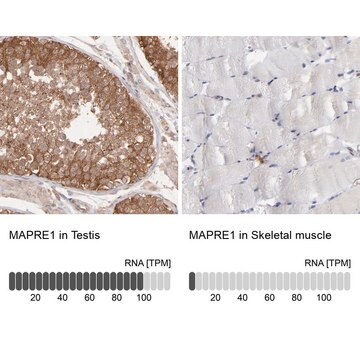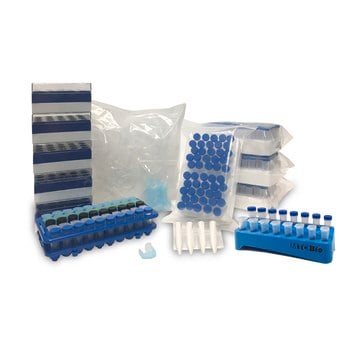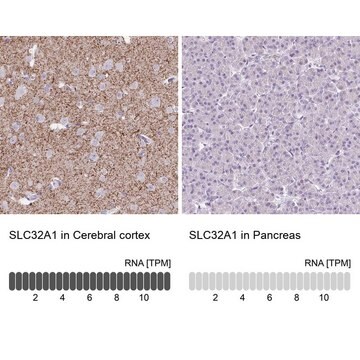一般說明
We are committed to bringing you greener alternative products, which adhere to one or more of The 12 Principles of Green Chemistry.This antibody is Preservative-free, produced without the harm or sacrifice of animals and exceptionally stable to allow for ambient shipping and storage if needed and thus aligns with "Waste Prevention", "Designing Safer Chemicals" and "Design for Energy Efficiency".
Click here for more information.
ZooMAb® antibodies represent an entirely new generation of recombinant monoclonal antibodies.
Each ZooMAb® antibody is manufactured using our proprietary recombinant expression system, purified to homogeneity, and precisely dispensed to produce robust and highly reproducible lot-to-lot consistency. Only top-performing clones are released for use by researchers. Each antibody is validated for high specificity and affinity across multiple applications, including its most commonly used application. ZooMAb® antibodies are reliably available and ready to ship when you need them.
特異性
Clone 1G19 is a ZooMAb® Rabbit recombinant monoclonal antibody that detects Tuberin/TSC2. It targets an epitope within 10 amino acids surrounding phosphoserine 939.
免疫原
KLH-conjugated linear peptide corresponding to 10 amino acids surrounding phosphoserine 939 from the internal region of human Tuberin/TSC2.
應用
Quality Control Testing
Evaluated by Western Blotting in HeLa treated with Anisomycin.
Western Blotting Analysis: A 1:10,000 dilution of this antibody detected phospho-Tuberin/TSC2-Ser939 in lysate from HeLa cells treated with Anisomycin (25 μg/mL; 30 min) but not in untreated cells.
Tested applications
Western Blotting Analysis: A 1:10,000 dilution from a representative lot detected phospho-TSC2-Ser939 in Hek293 treated with Anisomycin and phospho-TSC2/Tuberin-Ser939 Rinehart.
Immunohistochemistry (Paraffin) Analysis: A 1:1,000 dilution from a representative lot detected phospho-TSC2-Ser939 in human kidney and human prostate tissue sections.
Immunocytochemistry Analysis: A 1:100 dilution from a representative lot detected phospho-TSC2-Ser939 in HEK 293 treated with Anisomycin.
Peptide Inhibition Assay: Target band detection in lysate from HeLa cells treated with Anisomycin was prevented by preblocking of a representative lot with the immunogen phosphopeptide, but not the corresponding non-phosphopeptide.
Note: Actual optimal working dilutions must be determined by end user as specimens, and experimental conditions may vary with the end user
標靶描述
Tuberin (UniProt: P49815; also known as Tuberous sclerosis 2 protein) is encoded by the TSC2 (also known as TSC4) gene (Gene ID: 7249) in human. TSC2 is a peripheral membrane protein that serves as a tumor suppressor and is expressed in multiple tissues. In complex with TSC1, it inhibits the nutrient-mediated or growth factor-stimulated phosphorylation of S6K1 and EIF4EBP1 by negatively regulating mTORC1 signaling. It acts as a GTPase-activating protein (GAP) for the small GTPase Rheb, a direct activator of the protein kinase activity of mTORC1. In its C-terminal region is a highly conserved Rap-Gap domain (aa 1531-1758) that is essential for its function. TSC2 has been reported to increase the intrinsic GTPase activity of both Rap1A and Rab5 in vitro. It can undergo phosphorylation at serine 1387, 1418 or 1420. However, these phosphorylations do not affect its interaction with TSC1. It can also undergo phosphorylation at serine 939 and threonine 1462 by Akt1 induced by growth factor stimulation. When phosphorylated and activated by AMPK under conditions of low ATP:AMP ratio, it leads to negative regulation of the mTORC1 complex. AMPK-mediated phosphorylation leads to TSC1-TSC2 complex stabilization, increasing GAP activity toward Rheb and allows turning off mTORC1 signaling. This ZooMAb® recombinant monoclonal antibody, generated by our propriety technology, offers significantly enhanced specificity, affinity, reproducibility, and stability over conventional monoclonals. (Ref.: Li, Y., et al. (2004). Trends Biochem. Sci. 29(1); 32-38; Tee, AR., et al. (2002). Proc. Natl. Acad. Sci. USA. 99(21); 13571-13576
外觀
Purified recombinant rabbit monoclonal antibody IgG, lyophilized in PBS, 5% Trehalose, normal appearance a coarse or translucent resin. The PBS/trehalose components in the ZooMAb formulation can have the appearance of a semi-solid (bead like gel) after lyophilization. This is a normal phenomenon. Please follow the recommended reconstitution procedure in the data sheet to dissolve the semi-solid, bead-like, gel-appearing material. The resulting antibody solution is completely stable and functional as proven by full functional testing. Contains no biocide or preservatives, such as azide, or any animal by-products. Larger pack sizes provided as multiples of 25 μL.
重構
300 μg/mL after reconstitution at 25 μL per vial. Please refer to guidance on suggested starting dilutions and/or titers per application and sample type.
儲存和穩定性
Recommend storage of lyophilized product at 2-8°C; Before reconstitution, micro-centrifuge vials briefly to spin down material to bottom of the vial; Reconstitute each vial by adding 25 μL of filtered lab grade water or PBS; Reconstituted antibodies can be stored at 2-8°C, or -20°C for long term storage. Avoid repeated freeze-thaws.
法律資訊
ZooMAb is a registered trademark of Merck KGaA, Darmstadt, Germany
免責聲明
Unless otherwise stated in our catalog or other company documentation accompanying the product(s), our products are intended for research use only and are not to be used for any other purpose, which includes but is not limited to, unauthorized commercial uses, in vitro diagnostic uses, ex vivo or in vivo therapeutic uses or any type of consumption or application to humans or animals.









